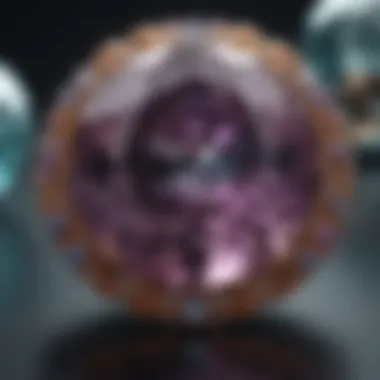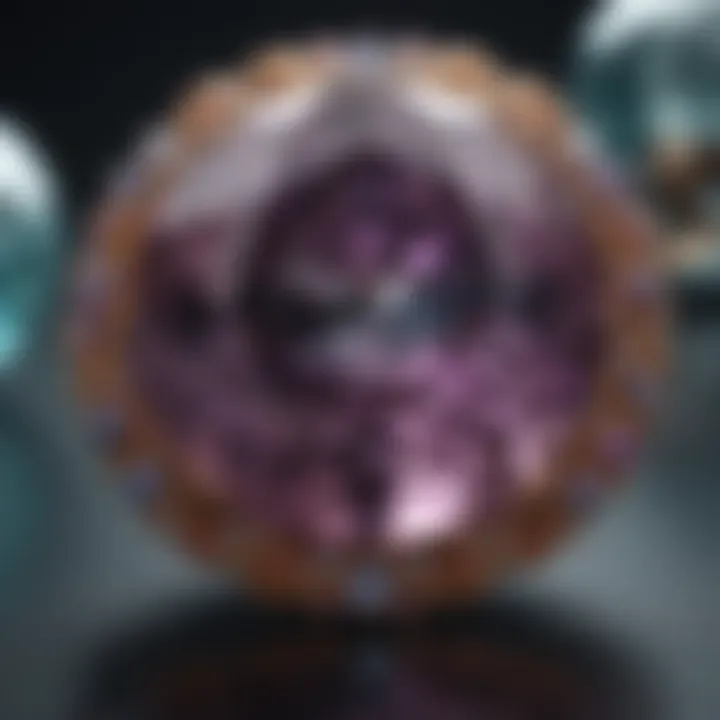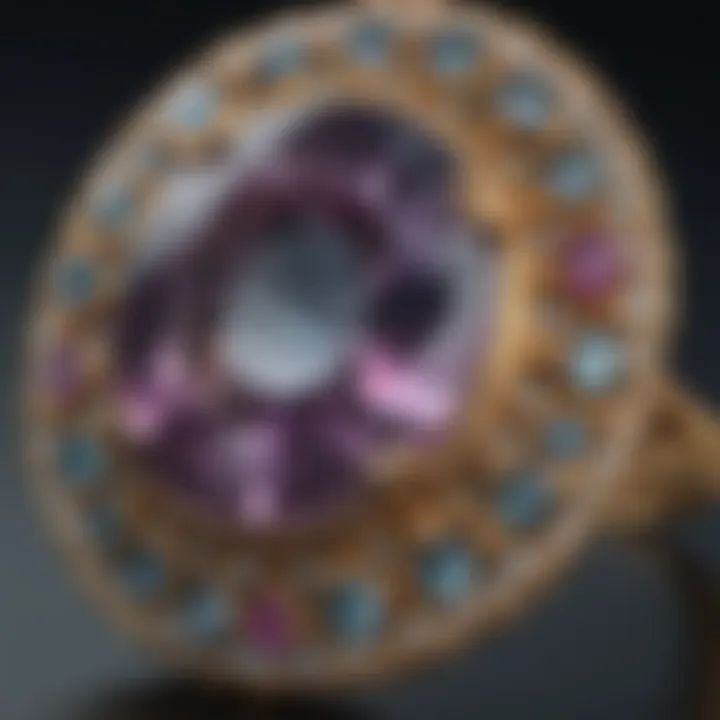Understanding Natural Alexandrite Pricing and Value


Intro
Natural alexandrite, a gemstone that shifts color from green to red depending on the light, has charmed collectors and enthusiasts for centuries. Its rarity and complex pricing landscape often leave people scratching their heads. Understanding the value of this unique stone is not merely about numbers; it involves a deep dive into its characteristics, historical significance, and the many factors that influence its cost.
In this article, we will explore the various aspects that contribute to the value of natural alexandrite. By investigating its properties, the market dynamics at play, and its cultural background, readers will gain a clearer view of what makes alexandrite not just a gemstone, but a fascination worthy of attention.
Gemstone Overview
Definition and Characteristics
Alexandrite is a variety of chrysoberyl, celebrated for its extraordinary color-change phenomenon. Under natural light, it appears a leafy green, while under incandescent light, it reveals a blush of reddish-purple. The chemical formula for alexandrite is BeAl2O4, which means it is primarily composed of beryllium and aluminum. This unique composition contributes to its distinctive optical properties.
Some key characteristics of natural alexandrite include:
- Color: Changes between green, brownish-green, and reddish-purple.
- Clarity: Most valued samples are eye-clean, but inclusions can add character.
- Cut: Quality settings enhance its brilliance and allow the color-change effect to take center stage.
Classification of Gemstones
Gemstones are classified based on several criteria, such as composition, hardness, and rarity. Alexandrite falls under the category of precious gemstones due to its beauty and scarcity. Unlike common stones, its price can skyrocket, especially for higher-quality specimens.
The classification of alexandrite can be broken down as follows:
- Natural: Mined from the earth, these stones are highly sought after.
- Synthetic: Lab-grown alternatives that mimic natural stones, but often lack the same value.
- Treatment: Many stones are enhanced through processes that improve color or clarity, which can impact their market value.
"Natural alexandrite carries with it the stories of the earth, reflecting not just beauty, but also history and craftsmanship."
Historical Significance
Ancient Uses and Cultural Importance
Dating back to the early 19th century, alexandrite was discovered in Russia and named after Czar Alexander II. Its captivating colors were often associated with imperial power and prosperity. In various cultures, it symbolized good fortune, love, and transformation. In some legends, it was believed to bring balance between the physical and spiritual worlds.
Not only was it popular among royalty, but it also made appearances in the world of jewelry design, enhancing pieces with a touch of opulence and uniqueness. The stone’s fascinating history is rich with cultural significance, making it more than just a pretty rock, but a conversation starter on heritage and artistry.
Myths and Legends Surrounding Gemstones
Throughout time, gemstones including alexandrite have inspired a web of myths and legends. Many believed that alexandrite possessed properties that could bring about change in fortune or fortune in love. In some circles, it was thought to have protective powers against harm and negativity.
Foreword to Alexandrite
Natural alexandrite stands as one of the most fascinating gemstones in the world, often referred to as a stone of changability due to its remarkable color-shifting properties. This section aims to provide an understanding of its significance in both historical and contemporary contexts, thereby setting the stage for a deeper exploration of its value.
Understanding natural alexandrite helps collectors and gemstone enthusiasts grasp not just the aesthetic appeal of the stone, but also its investment potential and market dynamics. As we dive into this subject, we’ll explore various elements that define the allure of alexandrite, such as its formation, rarity, and the unique features that differentiate it from other gemstones.
Historical Context
Alexandrite’s journey began in the Ural Mountains of Russia in the 1830s, where it was first discovered. The stone was named after Tsar Alexander II, and its discovery coincided with a period of national pride in Russia. Interestingly, it was initially mistaken for emerald due to its vivid green hue – a testament to the stone's striking appearance.
Over the years, the historical context surrounding alexandrite has evolved. In the late 19th century, as it gained prominence, it was presented in the royal court and became a symbol of luxury and style amongst aristocrats. This tie to nobility adds a layer of prestige, making it more than just a gemstone but a piece of history that reflects a time long past.
Notably, in some cultures, alexandrite has been linked to various metaphysical properties, such as bringing balance and harmony to the wearer’s life. The amalgamation of these historical narratives contributes to the stone’s aura, making it a desirable choice for both collectors and jewelry designers.
Importance in Gemstone Market
In the current gemstone market, natural alexandrite has carved out a niche as one of the rarest and most coveted gemstones available. Its unique color change feature, from green in daylight to red under incandescent light, has captivated gem enthusiasts across the globe. This rarity has fueled interest and driven up prices significantly, particularly for high-quality stones.
Several factors contribute to the importance of alexandrite in the gemstone market:
- Rarity: Natural alexandrite is quite scarce, especially stones with intense color changes and clear clarity. Many gemstones are found in abundance, but alexandrite stands out due to its limited availability.
- Market Demand: With an upsurge in interest among collectors and jewelry designers, the demand for alexandrite continues to grow. This shift in consumer preference signals a burgeoning market, ripe for investment.
- Cultural Significance: As a stone with deep historical roots and attributed metaphysical properties, it garners appeal not only for its beauty but also for what it represents culturally.
As we venture further into this article, we will discuss other facets including the factors affecting its price and the evaluation of its quality, in hopes of giving gemstone enthusiasts and collectors a comprehensive understanding of the value that natural alexandrite holds.
Understanding Natural Alexandrite
Gaining a proper understanding of natural alexandrite is vital in comprehending its allure in the gem market. This text delves into the geological processes behind its formation, the unique properties that make it so sought after, and the nuances of its color-changing characteristic that has captivated many over generations.


Formation and Composition
Natural alexandrite, a variety of chrysoberyl, is formed deep within the Earth’s crust under specific conditions of heat and pressure. Its chemical composition is primarily beryllium aluminum oxide, a rather simple structure that conceals its complexity. The presence of trace elements—most notably chromium—is what gives this gem its distinct coloration. As the gemstone forms, it often crystallizes in a way that allows light to reflect differently, resulting in an enticing color range.
Interestingly, the natural environment where alexandrite is found plays a huge role in its overall quality and appeal. Some of the most reputable locations for sourcing alexandrite include Brazil, Sri Lanka, and Russia. Each source imparts unique characteristics to the stones, which can impact their rarity and desirability on the market. While others may matter, the environment truly creates a backdrop for the distinctive beauty of each piece.
Color Change Phenomenon
One of the hallmark traits of natural alexandrite is its color-change phenomenon. This remarkable property allows the gem to shift colors depending on the lighting conditions. Under natural daylight, alexandrite commonly displays a greenish hue; however, indoors or under incandescent light, it can transition to a reddish or purplish shade.
This unique optical effect stems from the specific way that light interacts with the chemical composition and crystal structure of the gem. More than just a pretty trick, this color-change ability is crucial to determining its value in the marketplace. Gems that showcase a vivid color change, as well as a clear balance between the two colors, are regarded with higher esteem.
Such magnificent transformations add layers to alexandrite’s appeal. It’s like observing two different gems in one, mesmerizing collectors and jewelry designers alike. The dramatic shifts in appearance are what set alexandrite apart from many other treasured stones, making it a focal point of discussion among gemstone enthusiasts.
An important takeaway is that the remarkable qualities of natural alexandrite—as well as its formation and unique characteristics—underscore not only its beauty but also its intrinsic value in both personal and investment contexts. Understanding these elements equips collectors and enthusiasts with the knowledge needed to appreciate and invest in this extraordinary gemstone.
Factors Affecting Price
Understanding the factors that affect the price of natural alexandrite is crucial for anyone who is involved in gemstone trading or collecting. The complexity of this segment invites scrutiny about what elevates the worth of this rare gem, considering not just its physical attributes, but also market intricacies and availability. As precious stones endure fluctuating trends, being informed about pricing influences is essential for making wise investments and acquiring masterpieces.
Rarity and Availability
One of the foremost considerations in determining the price of natural alexandrite is its rarity. Unlike diamonds or emeralds, which are mined in larger quantities, alexandrite is considered quite scarce. Major deposits are primarily located in Brazil, Sri Lanka, and Russia, but as mining operations become exhausted, the availability diminishes. Some collectors and enthusiasts have noted that this gem can literally be as rare as hen's teeth.
Take note that size also plays a vital role in assessing rarity. Larger stones, especially those that exhibit the sought-after color change, are incredibly difficult to find. When a significant find occurs, the market temporarily adjusts, presenting new opportunities for price hikes. As a gem collector once remarked, "A rare alexandrite is not just a piece of jewelry; it's like owning a piece of history." This speaks volumes about the value associated with rarity in the gemstone market.
Quality Assessment Criteria
Next on the list of price determinants is the quality of the alexandrite itself. Gemstones are graded based on several criteria: clarity, cut, color, and carat weight. Each factor contributes to the overall beauty and desirability of the stone.
- Clarity: Inclusions can severely affect the gemstone's value. Higher clarity usually means a higher price. A clear stone can feel like holding a window to another world.
- Cut: The manner in which an alexandrite is cut affects its brilliance. A well-cut stone does more than dazzle; it improves the perception of color change, adding to its appeal.
- Color: The hallmark of alexandrite is its unique color change, generally shifting from green in daylight to red in incandescent light. The intensity and purity of these colors greatly influence the stone’s worth.
- Carat Weight: Naturally, larger stones command a higher price tag. However, it's important to note that the combination of these factors often outweighs carat weight alone in quality assessments.
As the market matures, there is a higher emphasis on these quality assessments. Dealers and collectors alike should be well-versed in this lexicon as they navigate buying and selling.
Market Demand and Trends
Finally, the market dynamics cannot be ignored. The demand for natural alexandrite fluctuates based on not only aesthetic preferences but also economic conditions. In a period where people are investing in tangible assets, alexandrite garners attention for its unique visual properties as well as its potential for appreciation.
Social trends play a role too. For instance, the increasing interest in ethical sourcing has made buyers more discerning about where their gemstones come from. As such, alexandrite mined through ethical channels can potentially fetch a higher price, aligning with the values of today’s consumer.
Monthly or yearly market reports often reveal a spike in prices during certain seasons, especially during festive periods when jewelers launch new collections.
In essence, staying attuned to these market trends can provide invaluable insights for collectors and investors anxious to navigate the fluctuations in alexandrite pricing.
"The trend for natural alexandrite is something to watch. As awareness increases, so do values," shared one seasoned gemologist in a recent interview.
Evaluating Alexandrite Quality
In the realm of gemstones, alexandrite holds a unique position, especially driven by its mystique and the complexities surrounding its valuation. Evaluating the quality of alexandrite is crucial not just for collectors, but also for jewelers and enthusiasts looking to make informed decisions. It involves a blend of various factors — including clarity, cut, and color quality standards — that ultimately dictate its worth in the market. An understanding of these elements can lead to more educated purchasing choices and a deeper appreciation for this magnificent stone.
Clarity and Cut
When it comes to gemstones, clarity often reigns supreme. In the case of alexandrite, clarity refers to how free the stone is from internal flaws, known as inclusions. Natural alexandrite is particularly sought after when it showcases minimal imperfections. Even minute inclusions can detract from its overall allure and value.
Cut, on the other hand, plays a crucial role in not only the aesthetics of the stone but also in how light refracts within it. A well-cut alexandrite will enhance its natural color change and brilliance.
Here are some key points to keep in mind when assessing clarity and cut:
- Inclusion Types: Look for types of inclusions. Some can be more acceptable than others while still maintaining value.
- Shape Possible: Certain cuts, like cushion or princess cuts, may highlight color shift more dramatically.
- Proportions Matter: Incorrectly proportioned cuts can lead to a dull appearance, shadowing the stone’s vibrant color change.
This evaluation means that both clarity and cut can substantially affect the alexandrite's market price. A higher clarity and excellent cut will often lead to a significantly greater price tag.
Color Quality Standards
Color is arguably where alexandrite shines most brightly, literally and figuratively. Known for its unique ability to change color based on the light source, natural alexandrite displays a green hue in daylight and shifts to a reddish-purple in incandescent light. This color-changing characteristic is a defining feature and is a significant factor in determining overall quality.
To meet general standards of color quality, consider the following:


- Color Tone: This refers to the lightness or darkness of the stone. Vibrant, rich colors generally command higher prices.
- Hue Variations: Look for stones that show strong contrast between the displayed colors. The more contrast, the better.
- Saturation Levels: A well-saturated color will result in a more appealing appearance, greatly impacting desirability.
"An alexandrite's ability to showcase two distinct colors under different lighting can significantly elevate its market value, making color quality the star of the show."
In summary, evaluating alexandrite quality involves a careful balancing act among clarity, cut, and color standards. Each element brings its nuances, and together, they create a comprehensive picture of what makes each stone precious. Knowledge of these factors not only enriches the appreciation of natural alexandrite but also equips enthusiasts with the means to navigate the intricate world of gemstone valuation.
Natural vs. Synthetic Alexandrite
The distinction between natural and synthetic alexandrite is essential for understanding its value in both commercial and aesthetic contexts. Natural alexandrite, a genuine gemstone that forms under specific geological conditions, offers a connection to the ancient Earth and the beauty of nature. On the other hand, synthetic alexandrite—created in laboratories using various techniques—holds differing attributes and implications for both pricing and desirability. These differences warrant close examination, especially for collectors and jewelry designers who seek authenticity and depth in their acquisitions.
Differences in Properties
When considering natural versus synthetic alexandrite, it’s important to highlight the key differences in their properties. Natural alexandrite’s formation is a lengthy process that can take millions of years, resulting in unique characteristics such as inclusions, color zoning, and changes in light reflection that contribute to its authenticity.
- Chemical Composition: Both types of alexandrite share the same chemical formula, being a variety of chrysoberyl. However, synthetic alternatives might have slight variations due to the artificial creation processes, potentially affecting their durability and clarity.
- Physical Characteristics: Natural alexandrite typically displays a more complex color-play. It can shift from green in daylight to reddish-purple under incandescent light, while synthetic versions often show less variability and may appear more uniform in hue.
- Inclusions: Natural stones often exhibit mineral inclusions or blemishes, serving as fingerprints that denote their authenticity. In contrast, synthetic alexandrite may lack such features or have distinctive inclusions that arise during the manufacturing process.
"Understanding these differences is pivotal for anyone investing in gemstones. Not all alexandrites are created equal."
Impact on Pricing
The price of alexandrite can vary significantly based on its natural or synthetic origins. Natural alexandrite tends to command higher prices because of its rarity and the intricate processes involved in its formation. On the flip side, synthetic alexandrite is usually more accessible and affordable, appealing to a broader range of consumers.
Key factors influencing pricing include:
- Rarity: Natural alexandrite is scarce, particularly in high-quality stones. This rarity translates to higher market value.
- Market Trends: As synthetic gemstones gain popularity for ethical and financial reasons, the market for natural alexandrite may fluctuate based on consumer preferences.
- Perceived Value: Buyers often assign more value to natural gemstones due to their unique properties and the story behind them.
In summary, while synthetic alexandrite presents an opportunity for mass production and lower costs, the allure of natural alexandrite lies in its authenticity and the intrinsic qualities it represents. This insight will help enthusiasts and collectors navigate the complex landscape of gem purchasing, ensuring they make informed decisions.
Sourcing Natural Alexandrite
Sourcing natural alexandrite is a vital aspect of understanding the gemstone's market, not just for collectors but also for jewelry designers and gem enthusiasts. The intricate journey of where and how this unique stone is mined plays a crucial role in determining its value, authenticity, and ethical considerations around its procurement.
Natural alexandrite is not just another pretty stone; its sources can be as varied and eclectic as the colors it displays. Collectors often seek out stones from specific regions, knowing that the geographical origin can affect not only the aesthetics but also the market appreciation of their pieces.
Major Mining Locations
The allure of alexandrite largely stems from its origins, with significant mines located in a few select areas around the globe.
- Russia: The most famous and historically significant mine is in the Ural Mountains. Russian alexandrites are famed for their rich colors and dynamic color changes.
- Brazil: More recently, the Bahia and Minas Gerais regions have yielded some impressive specimens that exhibit excellent color shifts and clarity.
- Sri Lanka: This region is recognized for alexandrites with vivid greens and purples, but they often come with a price tag that reflects their rarity.
- East Africa: Emerging locations in Tanzania and Madagascar are gaining attention, producing stones that are accessible to a wider audience but vary widely in quality.
Understanding these mining locations adds layers of complexity to the alexandrite market. Each region has its unique geological conditions, which can influence the final stone's color, clarity, and overall appeal.
Ethics in Gem Sourcing
The conversation around sourcing natural alexandrite demands a closer look at the ethical implications of mining practices. As the demand for unique gemstones rises, so does the potential for unethical practices within the industry. It is crucial for buyers to consider the origin of their stones, ensuring they are sourced responsibly.
- Fair Labor Practices: Sourcing from mines that treat their workers fairly benefits both the people involved and the reputation of the gem itself.
- Environmental Impact: Sustainable mining practices help in preserving the ecosystem while still allowing for gemstone extraction. Supporting such mines can yield not only beautiful stones but contribute to ecological well-being.
- Certification and Transparency: Gemstone certification becomes essential in this landscape. Documented origins can assure buyers they are investing in ethically sourced stones, which adds intrinsic value to their purchases.
"When sourcing gemstones, it's essential to ensure that your purchases reflect your values, merging beauty with responsibility."
Such ethical considerations can shape the dialogue around a purchase, infusing a greater sense of environmental and social responsibility into the gemstone market. In summary, effectively navigating the sourcing landscape of natural alexandrite involves understanding its geographical origins while being mindful of the ethical implications tied to mining practices.
Investment Potential
The realm of natural alexandrite isn't just an aesthetic adventure; it’s also a fascinating landscape for investment. The unique qualities of this gemstone have turned it into a coveted commodity, attracting not only collectors but also savvy investors. Understanding its investment potential requires a grasp of various elements that influence value.
A major facet of alexandrite’s investment allure stems from its intrinsic rarity. Natural alexandrite is exceedingly scarce, much like a needle in a haystack. Available supplies typically emerge from Brazil, Russia, and Tanzania, making any discovery particularly valuable. As mentioned earlier, the basic law of supply and demand amplifies its market presence. When availability drops and interest rises, the price tends to soar. Thus, investing in alexandrite can be likened to staking a claim on a rare piece of art or historic artifact – the less there is, the more valuable it becomes.
Another crucial element is the quality of the stone. Investors often look for pieces with exceptional clarity and color shift properties. Alexandrite's distinctive ability to change colors under different lighting can be a selling point that drives up the value. When grading these stones, professionals consider not just beauty but also the cut and clarity, which play significant roles in the overall appeal. Pieces graded higher not only fetch premium prices but also usually have better resale values, making them smarter investments.
Lastly, one must consider the current market trends. The popularity of natural gemstones has spiked in recent years, driven in part by increasing consumer demand for sustainable and ethically sourced materials. Alexandrite, often considered a unique gemstone for engagement rings or special occasion jewelry, continues to capture attention. Keeping an eye on industry news, auction results, and public interest can provide relevant insights into what stones may yield better returns over time.
"Investing in alexandrite is more than just a financial venture; it's about owning a piece of nature's art."
Market Analysis


When discussing the investment potential of natural alexandrite, a thorough market analysis is paramount. Potential investors need detailed information on pricing trends and demand fluctuations in the marketplace. It’s essential to track where alexandrite stands in comparison to other gemstones, such as diamonds and rubies, which can often overshadow it in glamour but are not as rare.
Several factors must be investigated:
- Comparative Pricing: Understanding how alexandrite pricing holds up against other rare gems can offer a clearer picture of its investment viability.
- Auction Insights: Checking previous auction results can offer da number of examples where stones similar in size and quality fetched high prices, shedding light on potential future values.
- Retail Trends: Analyzing current retail offerings can help gauge consumer demand. Retail prices may vary widely; thus, tracking well-known retailers or high-end jewelry designers can also provide insight into market behavior.
Risks Involved
Despite its potential, investing in natural alexandrite isn’t without risks. As with any investment, one must tread carefully and remain informed about possible pitfalls. Some of these risks include:
- Market Volatility: The gemstone market can be unpredictable. Factors such as economic downturns can quickly diminish demand, making price predictions complex and challenging.
- Quality Misjudgments: In an industry filled with fakes and synthetics, distinguishing genuine natural alexandrite from inferior alternatives necessitates expertise. Without proper knowledge, an investor can easily overlook quality indicators, leading to poor purchasing decisions.
- Limited Understanding of Trends: Failing to keep up with market trends can put investors at a disadvantage. What commands high value today may not necessarily maintain that stature in the future.
Comparative Analysis
Understanding the nuances of natural alexandrite in the context of other precious gems is critical for collectors and enthusiasts alike. This section aims to shed light on the unique attributes of alexandrite and draw parallels or distinctions with other gemstones, contributing to a fuller comprehension of its value and desirability in the market. By comparing its characteristics, aesthetics, and market behavior with other gems, one can better appreciate what makes alexandrite a star in the gemstone arena.
Alexandrite vs. Other Precious Gems
When discussing the splendor of gemstones, alexandrite often finds itself in select company. It stands out primarily due to its remarkable color-changing ability, a trait not commonly found in other gemstones. For instance, while ruby and sapphire showcase their strengths through rich hues, they do not possess the dynamic color shift from greens to reds that define natural alexandrite.
- Rarity: Alexandrite is famously rare, especially in its natural form, with some sources claiming fewer than a hundred gem-quality stones exist per year. In contrast, diamonds are produced in much larger quantities, although certain colors of diamonds can be equally rare, such as pink or blue.
- Historical Significance: Alexandrite's discovery dates back to the early 19th century, gaining prominence due to its association with royal figures. Other gems, like emerald, hold longstanding historical significance but often do not share the same modern appreciation as alexandrite.
- Market Appeal: The fluctuation of market demands plays a role as well. While pearls remain a classic choice for jewelry, alexandrite's recent resurgence in popularity can be linked to a growing interest in unique and distinctive pieces.
Moreover, when we think about emotional appeal, the rarity of alexandrite creates a certain allure that gemstones like amethyst or aquamarine cannot match. The profound risks associated with investing in such a rare gem also only enhance its value.
"Investors are increasingly drawn to stones they believe will appreciate, and alexandrite fits the bill perfectly due to its unparalleled charm and scarcity."
Price Comparison with Other Gemstones
Diving into the price disparities across gemstones reveals significant insights. Natural alexandrite prices can vary widely, influenced by factors such as clarity, size, and market demand. Collectors can expect to pay hundreds to thousands of dollars per carat, particularly for stones with exceptional color change properties.
In comparison:
- Diamond Prices can range from $2,000 to over $10,000 per carat depending on the quality factors like color, clarity, and cut. Thus, while diamonds can be more expensive based purely on market trends, the investment return on alexandrite often outperforms due to its increasing rarity.
- Emeralds range between $200 to over $3,000 per carat based on quality and origin. The price may climb for higher-quality stones, yet these gemstones are still more accessible than natural alexandrite.
- Ruby and sapphire also showcase price points that extend widely; however, precious varieties can sometimes hover around the same range as alexandrite.
Clearly, the financial dynamics of these gemstones illustrate that while natural alexandrite holds its ground alongside renowned gemstones, its distinct characteristics justify its sometimes astronomical prices—making it a compelling option for those looking to diversify or enhance their collections.
Caring for Alexandrite
Caring for alexandrite is a crucial aspect of maintaining its innate beauty and value. This remarkable gemstone, known for its color-changing properties, requires specific attention to preserve its quality and appearance. Understanding the care involved can greatly enhance the longevity and visual appeal of alexandrite, making it essential reading for collectors and enthusiasts.
Proper Cleaning Techniques
Cleaning natural alexandrite is not just about keeping it shiny; it’s about making sure that it remains free from debris and harmful substances that can dull its brilliance. Here are some effective cleaning techniques:
- Warm Soapy Water: The simplest and one of the safest methods. Mix a few drops of mild dish soap with warm (not hot) water. Soak the jewelry for a few minutes and gently clean with a soft brush, like a toothbrush, ensuring to get into crevices without scratching the stone.
- Avoid Harsh Chemicals: Stay away from harsh abrasives or strong chemicals, as these can alter the surface of the gemstone. Products containing bleach or ammonia can cause irreversible damage.
- Ultrasonic Cleaners: These devices can be tempting, but they may not always be safe for alexandrite. While some gems handle the vibration well, it’s better to err on the side of caution and use traditional methods.
Remember, frequent gentle cleans are better than infrequent harsh scrubs. A little bit of care goes a long way.
Storage Recommendations
How one stores alexandrite is just as important as how one cleans it. Proper storage can help avoid scratches and protect the gem from environmental factors. Here are some strategies:
- Soft Cloth Pouches: Always store alexandrite in soft cloth pouches. This minimizes the risk of it coming into contact with other jewelry that might scratch its surface.
- Separate Compartments: If you have a jewelry box, keep alexandrite pieces in separate compartments. This prevents them from rubbing against other stones or metals that could cause damage.
- Cool, Dry Place: Store the stone away from excessive heat and humidity to prevent any changes in appearance. A climate-controlled environment helps maintain its color quality.
- Avoid Direct Sunlight: Prolonged exposure to sunlight can affect the color quality of alexandrite. Keep it in a shaded spot to keep its brilliance intact.
In summary, by adopting proper cleaning techniques and ensuring appropriate storage, collectors can extend the life and beauty of their natural alexandrite gemstones. The benefits of caring for this precious stone cannot be overstated—it's about preserving a legacy and making a smart investment that potentially appreciates over time.
Epilogue
In summary, understanding the value of natural alexandrite offers rich insights for gemstone enthusiasts and collectors alike. This incredible gemstone, known for its unique color-changing ability, conveys not just beauty but also a fascinating history that intertwines with cultural significance and market dynamics. By grasping the various factors influencing alexandrite pricing, one can make more informed decisions when purchasing or investing in these precious stones.
Recap of Key Points
Throughout this article, several critical aspects have emerged that underscore the value of natural alexandrite:
- Rarity and Availability: The limited sources and geological conditions necessary for alexandrite formation contribute significantly to its worth. Unlike many gemstones, natural alexandrite is relatively scarce, elevating its status in the market.
- Quality Assessment Criteria: Factors such as clarity, color, and cut quality deeply impact the valuation of alexandrite. A gem with excellent characteristics can command a higher price, while those with certain imperfections may not carry the same financial weight.
- Market Trends: Analyzing past and present market trends provides an understanding of how demand fluctuates based on global interest. This can directly correlate with pricing, making it essential for investors to stay informed.
Future Trends in Alexandrite Pricing
Looking ahead, several potential trends may influence the pricing landscape of natural alexandrite:
- Increased Demand from Collectors: As more individuals discover the charm of alexandrite, its popularity is likely to rise. This situation could lead to increased competition in the market and thus could drive prices upward.
- Sustainable Sourcing: With growing awareness of ethical sourcing, natural alexandrite that comes from verified, responsible sources may attract buyers willing to pay a premium.
- Technological Advancements: Innovations in gemology and technology may lead to better detection of the authenticity of alexandrite, impacting consumer confidence and investment willingness.
In the end, as the natural alexandrite market evolves, it presents an exciting arena for both seasoned collectors and new enthusiasts. Keeping abreast of market movements and trends in this captivating field not only enriches one’s collection but enhances appreciation for this extraordinary gemstone.







